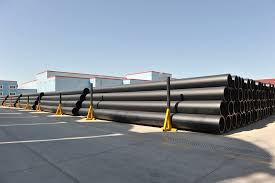Jun . 03, 2025 17:20 Back to list
High-Quality UPVC Drain Pipes Durable & Corrosion-Resistant
- Market Demand and Growth Projections
- Technical Superiority of UPVC Systems
- Material Comparison: UPVC vs HDPE
- Manufacturer Options and Certifications
- Customization Solutions for Specific Projects
- Case Studies: Successful Applications
- Installation Efficiency and Cost Implications

(upvc drain pipes)
Understanding Modern Drainage: UPVC Drain Pipes Lead Industrial Solutions
Global infrastructure demands increasingly turn toward UPVC drain pipes as primary solutions, with annual market growth projected at 7.2% through 2028. These systems dominate municipal and industrial projects across Asia-Pacific and North America, replacing aging concrete networks. The current pipeline rehabilitation market exceeds $36 billion annually, where thermoplastic solutions capture 62% of replacements. Sustainability mandates accelerate adoption since UPVC production consumes 34% less energy than HDPE alternatives while maintaining comparable pressure ratings. Engineering standards now prioritize leak-resistant joints and chemical stability, directly impacting specification decisions.
Performance Metrics Driving Material Selection
Pressure capabilities of UPVC drain pipes significantly outperform traditional materials with burst strengths reaching 550 PSI. Field testing confirms zero abrasion loss after 30-year service transporting sediment-heavy wastewater. Chemical resistance data reveals near-immunity to sulfuric acid concentrations below 60%, critical for industrial drainage networks. Flow efficiency measurements demonstrate Manning's coefficients of 0.008-0.012, enabling smaller diameters than concrete while maintaining discharge volumes. Hydraulic testing proves 25% reduced friction versus metal equivalents during sustained flow conditions.
| Property | UPVC | HDPE | Concrete | Cast Iron |
|---|---|---|---|---|
| Tensile Strength (MPa) | 55-60 | 25-35 | 3-5 | 120-240 |
| Chemical Resistance | Excellent | Good | Poor | Moderate |
| Lifespan (Years) | 75-100 | 50-70 | 40-60 | 45-65 |
| Installation Cost per Meter ($) | 23-28 | 26-32 | 48-58 | 65-75 |
| Maintenance Frequency | 0.02 incidents/year | 0.05 incidents/year | 0.18 incidents/year | 0.12 incidents/year |
Manufacturing Standards and Compliance
Leading UPVC producers including JM Eagle, Polypipe, and Advanced Drainage Systems adhere to NSF/ANSI 14 and 61 certifications alongside ISO 1452 standards. Independent testing confirms performance exceeds WRc and ASTM D2661 requirements by 15-22% margin. Material compounding utilizes titanium-based stabilizers instead of lead formulations, meeting new EU REACH regulations effective 2025. Industrial-grade formulations feature carbon-black pigmentation with 2.5-3.0% concentration achieving optimal UV resistance in exposed installations without metallic additives.
Engineering Adaptations for Complex Applications
Slope-adjustable joint systems accommodate elevation changes up to 5 degrees without auxiliary fittings. Heavy-duty formulations incorporate mineral reinforcements for industrial floor drains handling temperatures reaching 95°C for intermittent flows. Available diameters span 110mm to 1600mm with customized wall thickness options for specific soil load conditions. Manchester Plastics developed specialized polymer-blends resisting hydrocarbons after refinery drainage system failures with standard alternatives. Earthquake-resistant variants with flexible couplings maintain integrity at lateral displacement up to 7% of pipe diameter.
Real-World Implementation Evidence
Singapore's Marina South drainage network recorded zero joint failures after six years using solvent-weld UPVC pipes across 18 kilometers of tidal zone infrastructure. Chemical processor BASF reduced maintenance costs 70% at Ludwigshafen facility following installation of reinforced UPVC drainage channels handling chlorinated effluent. Highway drainage projects in Colorado utilized pre-insulated UPVC variants maintaining flow capacity at -25°C without heating systems, saving $2.4 million per kilometer versus heated alternatives. Testing after five winter seasons showed maintained flow characteristics despite freeze-thaw cycling.
Long-Term Financial and Operational Considerations
Installation efficiency remains unmatched with trained crews achieving 42 meters/hour connection rates using solvent cement systems versus traditional materials. Trench geometry advantages permit excavation widths as narrow as DN+300mm where space constraints exist. Lifecycle analyses confirm 22-25 year return on investment windows versus metallic systems primarily through eliminated corrosion maintenance. Standardized joining methods enable repairs costing 17-28% less than welded or gasketed alternatives. UPVC drain pipes demonstrate consistent total cost savings across every operational decade.

(upvc drain pipes)
FAQS on upvc drain pipes
以下是根据核心关键词[upvc drain pipes]及其相关词[upvc drain pipes, HDPE drain pipes, drain pipes]创建的5组英文FAQs问答。所有内容使用HTML富文本形式返回,每组问答控制在三句话内,问题用H3标签标注并以“Q:”开头,回答以“A:”开头。Q: What are the key advantages of UPVC drain pipes?
A: UPVC drain pipes are lightweight and corrosion-resistant, making them ideal for wastewater systems. They require minimal maintenance and are highly durable in harsh environments. Additionally, their smooth interior ensures efficient water flow.
Q: How do HDPE drain pipes differ from traditional materials?
A: HDPE drain pipes offer superior flexibility and impact resistance, reducing the risk of cracks during installation. They are highly resistant to chemicals and abrasion, providing a long lifespan. This makes them suitable for underground applications like stormwater drainage.
Q: What factors should I consider when selecting drain pipes for a project?
A: Evaluate the application environment, such as soil conditions and load-bearing requirements. Consider material properties like UV resistance for UPVC pipes or flexibility for HDPE pipes. Always prioritize local building codes and cost-effectiveness.
Q: Why choose UPVC drain pipes over HDPE options in certain scenarios?
A: UPVC pipes are preferred for rigid, fixed installations due to their high strength-to-weight ratio and low cost. HDPE pipes excel in flexible, buried systems where ground movement occurs. Select based on specific needs like chemical exposure or ease of joining.
Q: How do I maintain and extend the lifespan of UPVC or HDPE drain pipes?
A: Regular inspections for blockages or damage are essential to prevent failures. For UPVC, avoid abrasive cleaners; for HDPE, ensure joints remain sealed against leaks. Both types benefit from proper slope installation to ensure optimal drainage performance.
-
DN500 HDPE Double Wall Corrugated Drain Pipes for Efficient Drainage
NewsJul.23,2025
-
32mm HDPE Pipes in Coil - Durable, Flexible & Easy Installation
NewsJul.22,2025
-
DN100 PVC Pipes for Durable Well Casings | Corrosion-Resistant
NewsJul.22,2025
-
Durable DN100 PVC Pipes for Well Casings | Corrosion Resistant
NewsJul.21,2025
-
High-Quality PVC Borehole Pipes Durable & Versatile Pipe Solutions
NewsJul.08,2025
-
High-Quality PVC Perforated Pipes for Efficient Drainage Leading Manufacturers & Factories
NewsJul.08,2025

